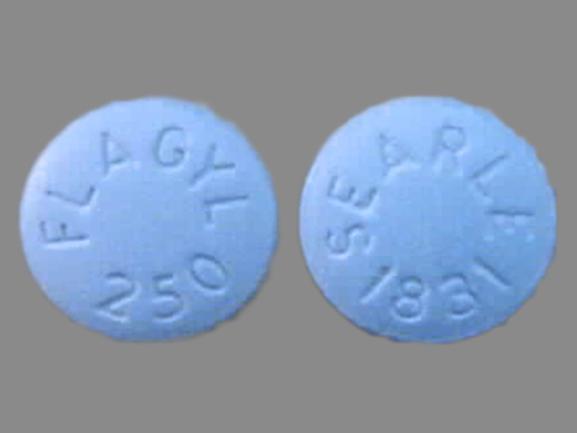Flagyl Disease Interactions
There are 7 disease interactions with Flagyl (metronidazole).
Antibiotics (applies to Flagyl) colitis
Major Potential Hazard, Moderate plausibility. Applicable conditions: Colitis/Enteritis (Noninfectious)
Clostridioides difficile-associated diarrhea (CDAD), formerly pseudomembranous colitis, has been reported with almost all antibacterial drugs and may range from mild diarrhea to fatal colitis. The most common culprits include clindamycin and lincomycin. Antibacterial therapy alters the normal flora of the colon, leading to overgrowth of C difficile, whose toxins A and B contribute to CDAD development. Morbidity and mortality are increased with hypertoxin-producing strains of C difficile; these infections can be resistant to antimicrobial therapy and may require colectomy. CDAD must be considered in all patients who present with diarrhea after antibacterial use. Since CDAD has been reported to occur more than 2 months after antibacterial use, careful medical history is necessary. Therapy with broad-spectrum antibacterials and other agents with significant antibacterial activity should be administered cautiously in patients with history of gastrointestinal disease, particularly colitis; pseudomembranous colitis (generally characterized by severe, persistent diarrhea and severe abdominal cramps, and sometimes associated with the passage of blood and mucus), if it occurs, may be more severe in these patients and may be associated with flares in underlying disease activity. Antibacterial drugs not directed against C difficile may need to be stopped if CDAD is suspected or confirmed. Appropriate fluid and electrolyte management, protein supplementation, antibacterial treatment of C difficile, and surgical evaluation should be started as clinically indicated.
Nitroimidazoles (applies to Flagyl) blood dyscrasias
Major Potential Hazard, Low plausibility. Applicable conditions: History - Blood Dyscrasias, Bone Marrow Depression/Low Blood Counts
The use of nitroimidazoles (e.g., metronidazole, tinidazole) has rarely been associated with hematologic adverse effects such as mild, transient leukopenia, thrombocytopenia, and bone marrow aplasia. The manufacturers recommend that therapy with nitroimidazoles be administered cautiously in patients with evidence of or a history of blood dyscrasias, and that total and differential leukocyte counts be performed before and after treatment with these drugs, particularly in patients receiving repeated courses of therapy.
Nitroimidazoles (applies to Flagyl) neurologic toxicity
Major Potential Hazard, Moderate plausibility. Applicable conditions: CNS Disorder, Peripheral Neuropathy
The use of nitroimidazoles (e.g., metronidazole, tinidazole) has been associated with the development of nervous system toxicity including convulsive seizures and dose-related peripheral neuropathy, the latter characterized primarily by numbness or paresthesia of an extremity. Persistent peripheral neuropathy has been reported in some patients treated for prolonged periods. Other neurologic adverse effects include vertigo, incoordination, ataxia, confusion, agitation, hallucinations, and depression. Therapy with nitroimidazoles should be administered cautiously in patients with or predisposed to seizures or other nervous system abnormalities. Nitroimidazole therapy should be discontinued promptly if neurologic disturbances occur.
Metronidazole (applies to Flagyl) dialysis
Moderate Potential Hazard, High plausibility. Applicable conditions: hemodialysis
Metronidazole and its metabolites are moderately removed by hemodialysis. Doses should either be scheduled for administration after dialysis or supplemental doses be given after dialysis.
Metronidazole (applies to Flagyl) liver disease
Moderate Potential Hazard, High plausibility.
Metronidazole is extensively metabolized by the liver to both pharmacologically active and inactive compounds. The plasma clearance of metronidazole may be decreased and the half-life prolonged in patients with impaired hepatic function. Therapy with metronidazole should be administered cautiously at reduced dosages in patients with severe liver disease.
Metronidazole (applies to Flagyl) sodium
Moderate Potential Hazard, High plausibility. Applicable conditions: Congestive Heart Failure, Hypertension, Fluid Retention, Hypernatremia
Flagyl I.V. RTU (brand of metronidazole ready-to-use injection) contains 14 mEq of sodium per each 500 mg dose of metronidazole. The sodium content should be considered when this product is used in patients with conditions that may require sodium restriction, such as congestive heart failure, hypertension, and fluid retention.
Nitroimidazoles (applies to Flagyl) alcoholism
Moderate Potential Hazard, Moderate plausibility.
Nitroimidazoles (e.g., metronidazole, tinidazole, fexinidazole, secnidazole) may inhibit alcohol dehydrogenase and occasionally precipitate a disulfiram-like reaction in patients who consume alcohol while being treated. Symptoms may include abdominal cramps, nausea, vomiting, headache, flushing, rash, weakness, diarrhea, abdominal pain, dizziness, sweating, and hypotension. Patients should be instructed to avoid alcohol-containing products during nitroimidazole therapy and for at least 48 hours (fexinidazole, secnidazole) to 72 hours (metronidazole, tinidazole) after the last dose. Therapy with nitroimidazoles should be administered cautiously in patients who might be prone to acute alcohol intake. An alternative therapy may be appropriate.
Flagyl drug interactions
There are 353 drug interactions with Flagyl (metronidazole).
Flagyl alcohol/food interactions
There are 2 alcohol/food interactions with Flagyl (metronidazole).
More about Flagyl (metronidazole)
- Flagyl consumer information
- Check interactions
- Compare alternatives
- Pricing & coupons
- Reviews (389)
- Drug images
- Side effects
- Dosage information
- Patient tips
- During pregnancy
- Generic availability
- Support group
- Drug class: amebicides
- Breastfeeding
- En español
Related treatment guides
Drug Interaction Classification
| Highly clinically significant. Avoid combinations; the risk of the interaction outweighs the benefit. | |
| Moderately clinically significant. Usually avoid combinations; use it only under special circumstances. | |
| Minimally clinically significant. Minimize risk; assess risk and consider an alternative drug, take steps to circumvent the interaction risk and/or institute a monitoring plan. | |
| No interaction information available. |
Further information
Always consult your healthcare provider to ensure the information displayed on this page applies to your personal circumstances.


